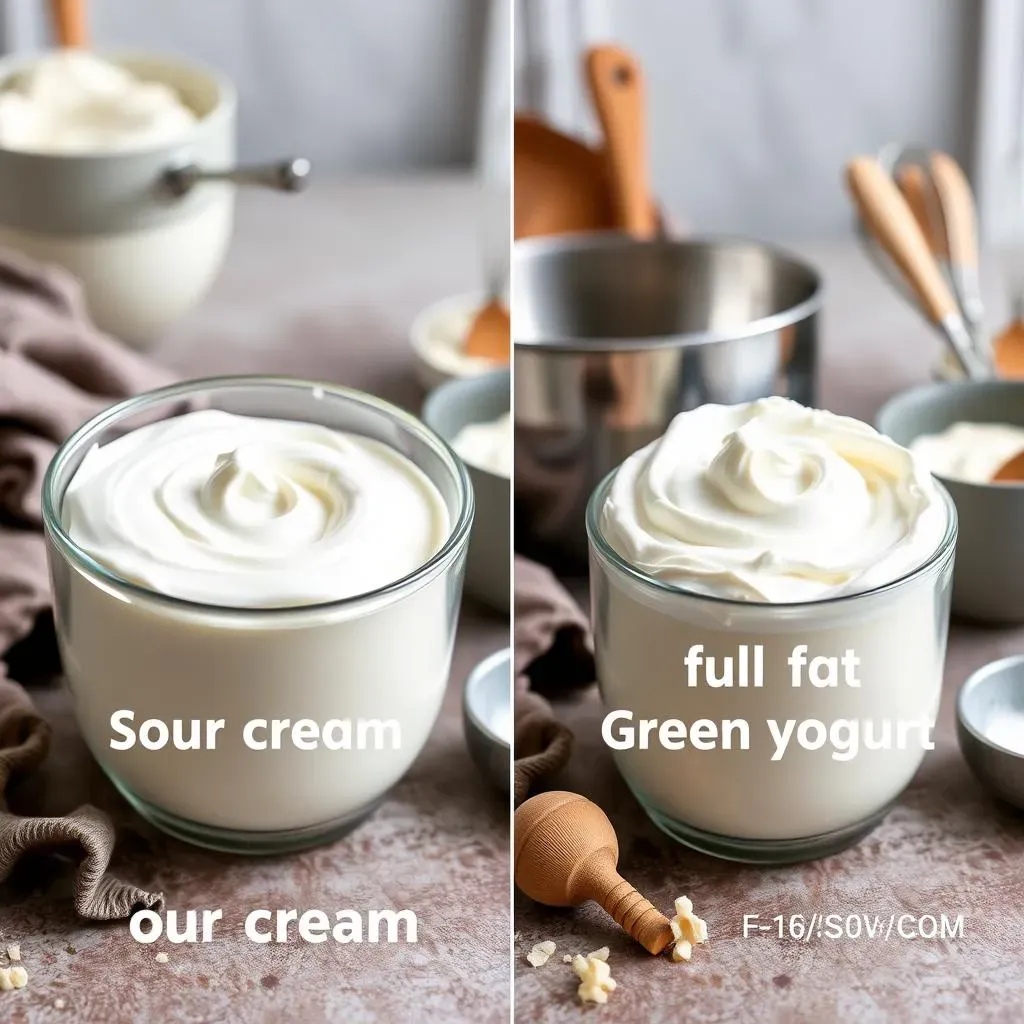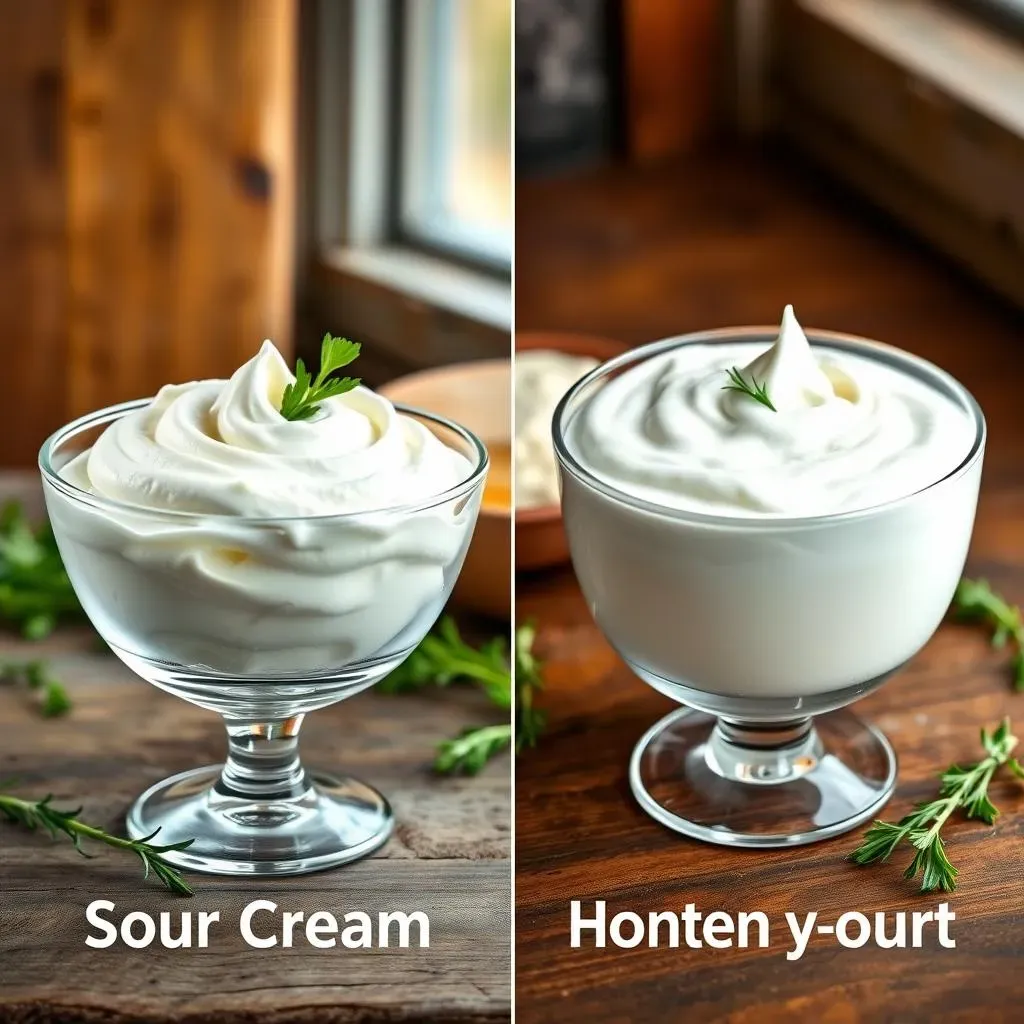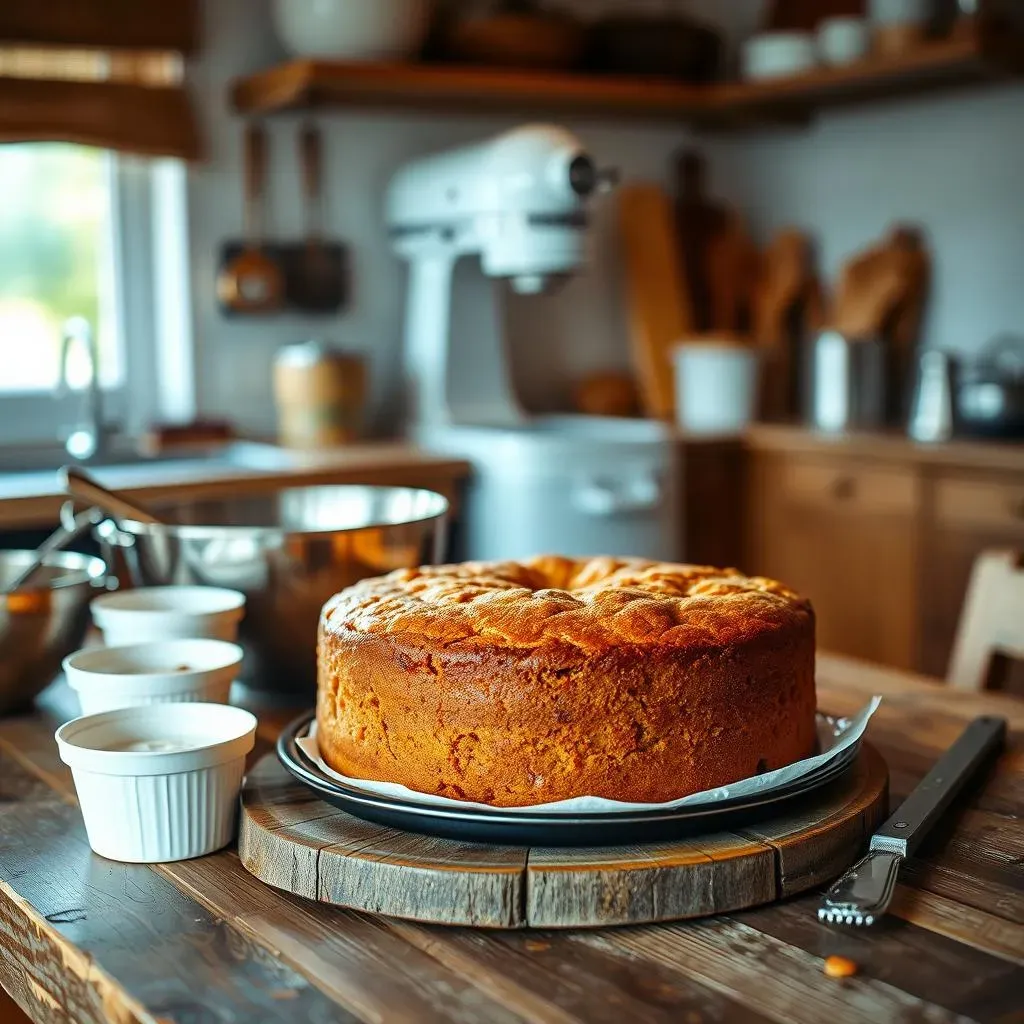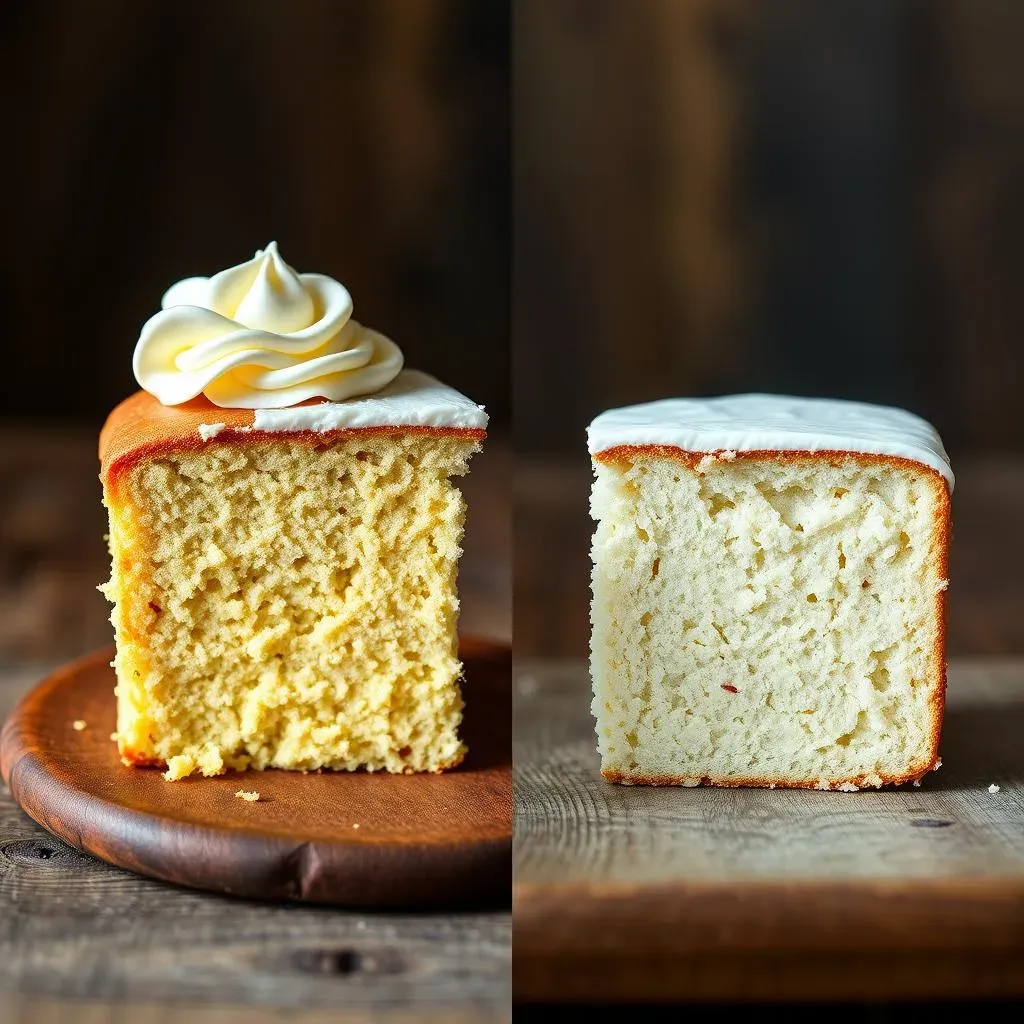Table of Contents
Ever stared blankly at a baking recipe, only to realize you're missing a key ingredient – sour cream? Don't panic! This article tackles the burning question: can you substitute sour cream for yogurt in baking? We'll explore the subtle yet significant differences between these two dairy products, examining their fat content, acidity, and how these factors influence baked goods. We'll then dive into practical tips and tricks for successfully using yogurt as a sour cream substitute, helping you achieve delicious results without compromising texture or taste. Finally, we'll look at specific recipes where this substitution works best (and where it might not!). Whether you're a seasoned baker or a kitchen novice, this guide will equip you with the knowledge to confidently navigate sour cream substitutions, ensuring your baking adventures are always a success. Let's get baking!
Can You Substitute Sour Cream for Yogurt in Baking?

Can You Substitute Sour Cream for Yogurt in Baking?
The Great Sour Cream vs. Yogurt Debate
So, you're wondering if you can swap sour cream for yogurt in your baking? It's a common question, and the short answer is... sometimes! Both sour cream and yogurt bring moisture and a touch of tang to baked goods, but they aren't exactly the same. Sour cream generally boasts a higher fat content and a slightly sharper tang. This richer texture and bolder flavor can significantly impact the final product. Think of it like this: sour cream is the bold, seasoned veteran of the dairy world, while yogurt is the versatile, slightly sweeter newcomer.
The success of your substitution hinges on several factors. The type of yogurt you use matters significantly. Full-fat Greek yogurt is your closest ally due to its thick consistency and tangy flavor profile, closely resembling sour cream. However, even with Greek yogurt, you might need to tweak the recipe slightly – we'll cover this in more detail later. Don't even think about using those thin, watery yogurts; you'll end up with a disaster.
Ingredient | Fat Content (Approximate) | Acidity | Texture |
|---|---|---|---|
Sour Cream | 18-30% | High | Thick, Creamy |
Full-Fat Greek Yogurt | 10-15% | Medium-High | Thick, Creamy |
Regular Yogurt | 2-8% | Medium | Thin |
Factors Influencing the Substitution
The type of baked good plays a crucial role. In recipes where sour cream contributes significantly to the texture, like muffins or cakes, the substitution might alter the final result. You might find a slightly drier or less rich texture with yogurt. However, in recipes where sour cream is primarily a flavor enhancer, such as some dips or glazes, the substitution is often seamless. Consider the recipe's other ingredients too; if it's already quite rich, the lower fat content of yogurt might be a welcome change.
Remember, baking is a science. Don't be afraid to experiment! Start with a small batch to test the waters. If the first attempt isn't perfect, adjust the recipe in your next try. You might need to add a bit more liquid to compensate for the lower fat content of yogurt or even add a tablespoon of melted butter for added richness. It’s all about finding the right balance.
- Consider the recipe's overall richness.
- Experiment with different types of yogurt.
- Don't be afraid to adjust other ingredients.
Understanding the Differences: Sour Cream vs. Yogurt

Understanding the Differences: Sour Cream vs. Yogurt
Understanding the Differences: Sour Cream vs. Yogurt
Let's get down to the nitty-gritty: what truly sets sour cream apart from yogurt? It's not just a matter of semantics; the differences in their composition directly impact how they behave in baking. The primary distinction lies in their fat content and resulting texture. Sour cream, a cultured cream product, typically boasts a higher fat percentage (around 18-30%), leading to its characteristic thick, rich consistency. This higher fat content also contributes to a creamier mouthfeel in baked goods. Yogurt, on the other hand, is made from fermented milk, and its fat content varies greatly depending on the type. Full-fat Greek yogurt comes closest to sour cream in thickness, but still generally contains less fat (10-15%). Regular yogurt often has a much lower fat content (2-8%) and a thinner consistency. Think of it like this: sour cream is the luxurious velvet, and yogurt is the comfortable cotton.
Beyond fat content, acidity also plays a crucial role. Sour cream generally has a higher acidity level, resulting in a more pronounced tang. This tanginess can cut through sweetness in baked goods, adding a delightful contrast. Yogurt's acidity varies depending on the type and brand, but it's usually less intense than sour cream's. This difference in acidity can subtly affect the overall flavor profile of your baked goods. Remember, a little acidity goes a long way! Too much tang can overpower other flavors, while too little might leave your baked goods feeling a bit flat.
- Fat Content: Sour cream (18-30%), Full-fat Greek Yogurt (10-15%), Regular Yogurt (2-8%)
- Texture: Sour cream (Thick, Creamy), Full-fat Greek Yogurt (Thick, but less creamy), Regular Yogurt (Thin)
- Acidity: Sour cream (High), Full-fat Greek Yogurt (Medium-High), Regular Yogurt (Medium)
Baking with Sour Cream Substitutes: Tips and Tricks

Baking with Sour Cream Substitutes: Tips and Tricks
Choosing the Right Yogurt
First things first: Not all yogurts are created equal. When substituting sour cream, full-fat Greek yogurt is your best bet. Its thicker consistency and tangy flavor profile most closely mimic sour cream. Avoid using low-fat or non-fat yogurts; their thinner consistency will likely result in a drier or less rich final product. Even with full-fat Greek yogurt, you might need to adjust your recipe slightly, so be prepared to experiment a little. Think of it as a culinary adventure!
Remember, the goal is to replicate the moisture and tang that sour cream provides. If your chosen yogurt is a bit less tangy than you'd like, a squeeze of lemon juice can help. Conversely, if your yogurt is too tart, a pinch of sugar might balance the flavors. It's all about finding the perfect harmony!
Yogurt Type | Best for Substitution? | Notes |
|---|---|---|
Full-Fat Greek Yogurt | Yes | Closest in texture and tang to sour cream |
Low-Fat Greek Yogurt | Maybe | May result in a drier product; add extra liquid |
Regular Yogurt | No | Too thin; likely to significantly alter texture |
Adjusting Your Recipe
Since yogurt generally has a lower fat content than sour cream, you might need to adjust the recipe's liquid content. If you're using yogurt as a direct swap, the baked good might be slightly drier. To compensate, you could add a tablespoon or two of milk, buttermilk, or even melted butter to increase moisture and richness. The exact amount will depend on the recipe and the type of yogurt you're using. Start with a small addition and gradually increase it as needed. Think of it as a delicate dance between ingredients.
Don’t forget about baking time! Because of the differences in fat and moisture content, your baking time might need adjusting. The lower fat content of yogurt may result in a slightly faster baking time. Keep a close eye on your baked goods, and use a toothpick to check for doneness. It's better to slightly underbake than to overbake. Remember, a slightly underbaked cake is still edible, but a burnt one is not!
- Add 1-2 tablespoons of milk or buttermilk for extra moisture.
- Consider adding a tablespoon of melted butter for richness.
- Reduce baking time by a few minutes; check for doneness with a toothpick.
Troubleshooting Common Issues
Even with careful adjustments, you might encounter some unexpected results. If your baked goods turn out slightly dry, don't despair! Next time, add a little more liquid. If they're too dense or heavy, try reducing the amount of yogurt slightly. Experimentation is key! Each recipe and each type of yogurt will behave differently. Remember that baking is a journey of discovery, not just a race to the finish line.
Don't be afraid to taste-test as you go. Adjusting sweetness or tanginess is easy. A little extra sugar can compensate for a less-tangy yogurt, and a squeeze of lemon juice can add a bit of zing if needed. Ultimately, the best way to master sour cream substitutions is through practice and experimentation.
Can You Substitute Sour Cream for Yogurt in Specific Recipes?

Can You Substitute Sour Cream for Yogurt in Specific Recipes?
Cakes and Muffins: A Cautious Approach
Cakes and muffins are where the substitution gets tricky. Sour cream contributes significantly to the moisture and tender crumb of these baked goods. While you *can* use full-fat Greek yogurt, be prepared for a slightly drier texture. The lower fat content of yogurt might result in a denser cake or muffin, and the tang might be less pronounced. To compensate, try adding a tablespoon or two of extra milk or buttermilk to the batter. You might also consider reducing the baking time slightly to prevent over-drying. Don't be afraid to experiment! Start by substituting only half of the sour cream with yogurt to see how it affects the outcome.
Remember, every recipe is unique. A recipe calling for a small amount of sour cream might tolerate the substitution better than one relying heavily on it for moisture. Always check the recipe's other ingredients; if it's already quite dry, using yogurt might be a recipe for disaster. If you're making a particularly delicate cake, it's probably best to stick with sour cream or find an alternative substitute altogether. For example, applesauce or mashed banana can sometimes work well.
Recipe Type | Substitution Success? | Tips |
|---|---|---|
Pound Cake | Low | Avoid substitution; the texture will suffer greatly |
Carrot Cake | Medium | Add extra moisture; reduce baking time |
Muffins | High | Use full-fat Greek yogurt; may require minor adjustments |
Savory Dishes and Dips: A Winning Combination
In contrast to cakes and muffins, savory dishes and dips often welcome the substitution of yogurt for sour cream with open arms. The tangy flavor of yogurt complements many savory ingredients beautifully, and the slight difference in texture is often unnoticeable, or even desirable. Think creamy dips for veggies, tangy sauces for tacos, or a zesty topping for chili. In these applications, the lower fat content of yogurt might even be a welcome advantage for those watching their calorie intake.
When substituting in savory dishes, full-fat Greek yogurt is again your best friend. However, you may need to adjust seasonings to compensate for the slightly milder tang of yogurt compared to sour cream. A pinch of extra salt, a dash of lemon juice, or a sprinkle of your favorite herbs can elevate the flavor profile and make the substitution seamless. Don't be afraid to get creative and experiment with different flavor combinations. After all, cooking (and baking) is all about having fun and exploring new possibilities!
- Consider adding a pinch of salt or garlic powder to enhance flavor.
- A squeeze of lemon juice can boost acidity.
- Experiment with herbs and spices to create unique flavor profiles.